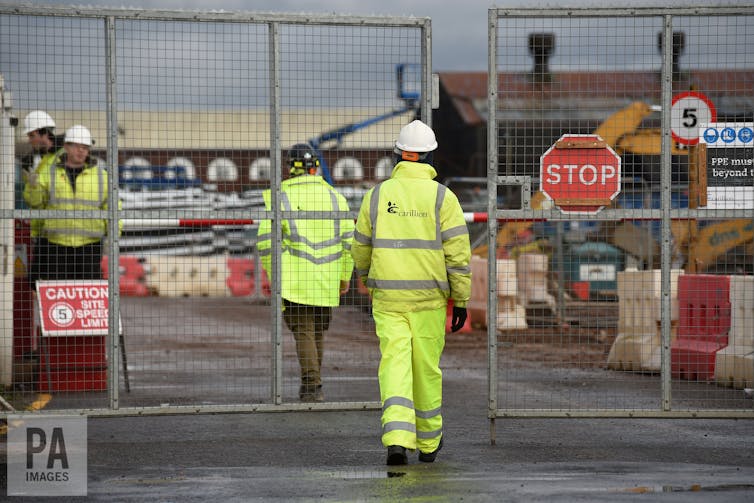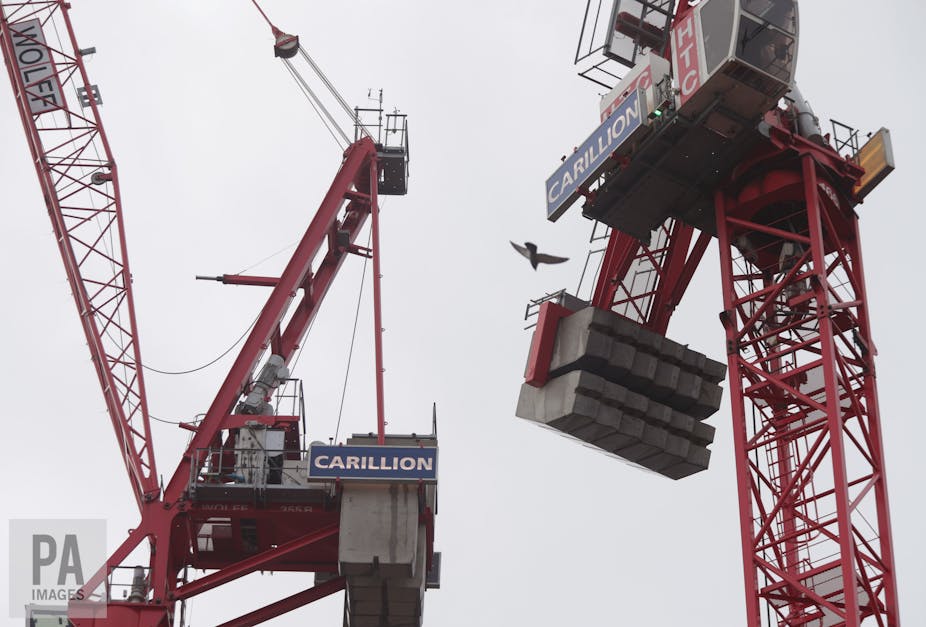Construction giant Carillion has gone into liquidation. The UK’s second-largest construction firm was one of the government’s biggest contractors, involved in huge infrastructure projects like the HS2 rail link and the Royal Liverpool University Hospital. It also provides services across the public sector such as running libraries, schools and prisons. Here’s what you need to know about Carillion’s collapse.
Why did the government keep placing work with Carillion despite profit warnings and huge debts?
It is possible that the government did this to keep Carillion solvent. But, as we’ve seen, there is always a day of reckoning.
Carillion seems to have a number of long-term contracts which have been losing money. There is a view by some I’ve spoken to in the industry that they have been tendering at low prices to keep winning work. In the contracting industry the developer pays significant sums up front to get projects moving. The projects can last a number of years and management has to assess whether the project is losing money or will make a profit. In effect, Carillion may have been using the new money from contract wins to shore up the old loss making contracts.
Some of the issues arose during the recession that followed the 2007-08 financial crisis, when contractors bid lower prices to keep winning work and keep their sub-contractors and employees occupied. These contracts have been losing money ever since. Balfour Beatty ran into similar problems in 2015 when major losses were taken on contracts. Fortunately, they had plenty of saleable assets which would act as collateral for further borrowing, and they did not have the debt levels of Carillion.
Clearly, there are big questions which the directors and the auditors need to answer regarding taking so long to realise their predicament. There is also a question around directors’ bonuses and pay during the last few years and whether the accounts should have told a different story.
We can be reasonably certain that no one will come out of the catastrophic collapse of Carillion with any real dignity.
What are the consequences of collapse?
Carillion’s collapse leaves almost £1 billion of debt, more than £500m of pension deficit and around 30,000 unpaid subcontractors. Work is ceasing on both public and private contracts as subcontractors down tools until they receive reassurance that they will be paid – for past and future work. The liquidator and Official Receiver is asking subcontractors to keep working but they are likely to require strong reassurances regarding payment.
The cash paid by government and private developers into Carillion before its collapse – which had not been previously paid to subcontractors – can be presumed to be lost. Carillion’s head office will probably close and the regional management structure dissolved as job losses mount.
Broadly, the business has two parts: major capital contracts (building of hospitals, roads, railways and other major structures) and facilities management (buildings maintenance, security, catering, running prisons and so on).
Facilities management is predominantly, but not exclusively, for the government. Clearly, these latter jobs were originally undertaken by public sector workers until outsourced to private contractors.
In this area, it can be argued that the government has a choice as to whether it nationalises this work or continues to rely on private contractors. There is little doubt that private contractors are cheaper because the market to provide these services is highly competitive. But there are risks over the quality of work, failure to perform and, as in this case, liquidation.
There are plenty of businesses willing to provide these services, such as Serco and Sodexo. Retendering is likely to produce a low cost solution but the government should learn from its mistakes with the Carillion experience and make sure it gives the contract to a financially stable company, including substantial penalties for poor performance.

Government-funded major capital schemes can only be performed by major external contractors. There are only a few businesses which have the size and specialist skills to do this work. These include Balfour Beatty, Galliford Try, and a few others.
There are also overseas contractors but governments typically give as much work to domestic firms as possible, provided the skills and capabilities exist.
What should the government do?
The government has made some promises to pay subcontractors working on public contracts. But the key question for the 30,000 subcontractors is what will happen to the money owed for work over the last few months? If this is not paid then they may become insolvent and the major hospitals, roads and railways will be delayed for a considerable time.
In effect, the government and other developers have paid this money into Carillion but it is lost. To ensure solvency and continued work on the major projects, the government will have to stand these losses and ensure that subcontractors are paid what they are owed.
They have no reason, however, to cover the private contracts. These are for the private developers to make a decision over.
Nationalising Carillion would be highly risky for several reasons. The government would have to take on all the liabilities for both public and private contracts. Other major contractors would, in effect, have to compete with a government-owned contractor for work which would scarcely be ideal as the government does not have to make a profit or pay for its capital. Finally, what does the government know about contracting? It would appear very little from this saga.
What we do know is that these major public-private partnership schemes will continue and that the bulk of employment will continue albeit after some disruption. Continued competition does drive a good deal for developers, including the government, but, as we have seen, also has its risks.

